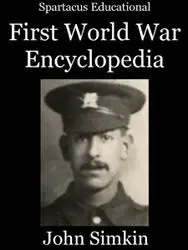Charles Jarvis
Charles Jarvis, the son of a coastguard, was born in Fraserburgh, Scotland. After attending Carnoustie School, Jarvis joined the British Army and served overseas before leaving in 1907.
On the outbreak of the First World War Jarvis joined the Royal Engineers. He was immediately sent to France with the British Expeditionary Force and arrived at Mons on 22nd August, 1914. The following day Lance-Corporal Jarvis was one of the members of the men sent to destroy eight of the bridges over the Mons-Conde Canal. Although coming heavy fire from German fire, Jarvis managed to blow up the bridge at Jemappes.
For his actions at Mons Jarvis was awarded the Victoria Cross. He returned to England and was presented with the medal at Buckingham Palace on 13th January, 1915.
In January 1917 Jarvis was dismissed from the British Army after over 17 years service. He claimed in an interview with the London Star that the authorities had done this to avoid paying him the pension granted to men with 18 years' service.
After leaving the army Jarvis found work as a labourer. During the Second World War he was employed at Portsmouth Dockyard.
Charles Jarvis died in Dundee on 19th November 1948.
Primary and Secondary Sources
(1) The Sapper (February, 1915)
Lance-Corporal Jarvis and Sapper Neary were detailed with B Company Royal Scots Fusiliers, and ordered to prepare one of the bridges for demolition in case of retirement. During the work of placing the charges of the fire of the enemy gradually increased in violence. Lance Corporal Jarvis despatched Sapper Neary to obtain the exploder and leads, which were in the possession of another party under Corporal Wiltshire.
Lance-Corporal was called upon to destroy the bridge, but was still without the exploder and leads, as the sapper had not returned. He crawled out over the bank, and got into the street, where he commandeered a bicycle from a Belgian, and was riding towards the market square to find the exploder himself, when he met Captain Wright, who was then wounded in the head. Wright told Jarvis to go back to the bridge and be prepared to connect up the leads, as he would fetch them in a motor car, and taking the bicycle from Jarvis, went off to fetch the necessary articles.
Jarvis returned to his former position to await the return of Captain Wright. After working for about one and half hours Jarvis did finally manage to successfully fire the charges for the bridge's demolition, which probably saved the lives of many British troops.
(2) After destroying the Jemappes Bridge, Charles Jarvis commented on the bravery of Captain Theodore Wright.
The work on the bridge was done under fire from three sides. Near the bridge I found Captain Theodore Wright, wounded in the head. I wished to bandage him but he said, "Go back to the bridge." It must be done - and so I went."
(3) Fraserburgh Herald (9th January, 1917)
Corporal Charles Jarvis the first hero who received the Victoria Cross in the present war, has over 17 years' service to his credit. In ten months (November, 1917) he would be entitled to the pension granted to men with 18 years' service. A year ago (January 1916) he answered a call for volunteers for munition work, and as a skilled mechanic he has been so employed since. Last week he was suddenly presented by the civilian manager of the works where he is engaged with his discharge from the enemy. The effect of that is to deprive him of the opportunity of becoming eligible for his 18 years' pension.
(4) Charles Jarvis, interviewed by the London Star (January, 1917)
I want to know what I am discharged for? I am 35 years old, perfectly sound, and perfectly ready to go out to the front again if I am wanted. I do not believe that the authorities are acting legally in discharging me in this way. I have the best possible character from my officers. I mean to expose the meanness of the practice, and see whether the public approves such treatment for the men who went through the first and heaviest fighting of the war.

